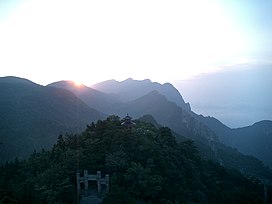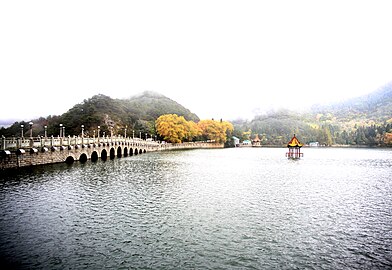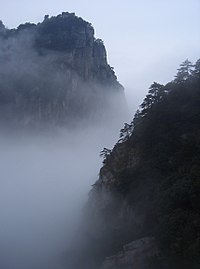Mount Lu
This articleneeds additional citations forverification.(February 2020) |
| Mount Lu | |
|---|---|
 | |
| Highest point | |
| Elevation | 4,836 ft (1,474 m) |
| Coordinates | 29°33′34″N115°59′36″E/ 29.5594°N 115.9934°E |
| Geography | |
| Location | Lushan National Park,Jiangxi, China. |
| Official name | Lushan National Park |
| Criteria | Cultural: ii, iii, vi, v, vi |
| Reference | 778 |
| Inscription | 1996 (20thSession) |
| Area | 30,200 ha |
Mount LuorLushan[1](simplified Chinese:Lư Sơn;traditional Chinese:Lư Sơn;pinyin:Lúshān,Gan:Lu-san) is a mountain situated inJiu gian g,China. It was also known asKuanglu(Khuông lư) in ancient times. The mountain and its immediate area are officially designated as the Lushan National Park, and it is one of the most renowned mountains in the country. Mount Lu is located primarily inLushan CitywithinJiu gian g,although its northern portions are found in Jiu gian g'sLianxi District.The oval-shaped mountains are about 25 kilometers (16 mi) long and 10 kilometers (6.2 mi) wide, and neighborsJiu gian gand theYangtze Riverto the north,Nanchangto the south, andPoyang Laketo the east. Its highest point is Dahanyang Peak (Đại hán dương phong), reaching 1,474 meters (4,836 ft) above sea level. Dahayang Peak is also one of the hundreds of steep peaks that tower above the so-calledsea of cloudsthat can encompass the mountain for almost 200 days each year.
Mount Lu is known for its grandeur, steepness, and beauty and is a prominent tourist attraction, especially during the summer months when the weather is cooler in the mountains than elsewhere. The mountain and the surrounding region is also one of the "spiritual centers" of China, containing manyBuddhistandDaoist templesin addition to landmarks ofConfucianism.[2]Due to its striking beauty and sacred importance, Lushan National Park has been aUNESCOWorld Heritage Sitesince 1996.[2]The overlappingLushan Quaternary Glaciation National Geoparkis a member of theUNESCO Global Geoparks Network.
History
[edit]Mount Lu contains important sites and temples forDaoism,(Mahayana)Buddhism,Confucianism,and evenChristianity.[3]Between AD 386 and 402 during theJin dynasty,HuiyuanfoundedPure Land BuddhismandDonglin Templeon the slopes of Mount Lu.[2]During theTang dynasty(618–907), Daoist temples were constructed nearby to house sacred scriptures.[2]TheWhite Deer Grotto Academy,founded in AD 940, was developed into a renowned center of academic research during theSong dynastyunder the direction of Confucian scholarZhu Xi.[2]The academy was continually open until at least the 19th century. Other important medieval structures on the mountain include the grave of the famous Tang dynasty poetTao Yuanmingand imperial pavilions during theMing dynasty.[citation needed]
The Song dynasty poetSu Shifamously described the difficulty of conveying the mountain's beauty in his expression, "Why can't I tell the true shape of Lushan? Because I myself am in the mountain."[4]
In later years,Kulingin Mount Lu became a summer resort for Western missionaries in China.Absalom Sydenstricker,the father ofPearl Buck,was one of the first five missionaries to acquire a property in the Kuling Estate on the mountain. The development of Kuling was instigated by the Reverend Edward Little and Dr. Edgerton H. Hart.[5][page needed]The four principal founders of China's Nurses Association and its first president, Caroline Maddock Hart, met in Kuling to form this association.[6][page needed]
During theLong March,in early 1935, a battle took place in the area between theChinese Red Armyandnationalistforces,in whichHu Yaobang,laterGeneral Secretary of the Chinese Communist Party,was seriously injured.[7]
Mount Lu was once dubbed thehsiatu(xiadu,"summer capital" ) of theRepublic of China.Chiang Kai-shek,China's leader at the time, would frequently spend his summers in the area. In June 1937,Zhou Enlai,then a major leader in theChinese Communist Party,met with Chiang on the mountain to discuss aunited frontagainst the Japanese invasion. In July 1937, Chiang Kai-shek announced his intention for a full mobilization forwar against Japanfrom Mount Lu. In 1946, following the war, the U.S. special diplomatic mission led by GeneralGeorge C. Marshallmet with Chiang Kai-Shek to discuss the role of post-World War II China.[citation needed]
Mao Zedongconvened three large conferences of senior party officials at Mount Lu, in 1959, 1961, and 1970. The 1959 conference became known as theLushan Conference.The meeting saw the purge of decoratedChinese Civil WarandKorean WargeneralPeng Dehuai,who was critical of Mao'sGreat Leap Forwardpolicies. The 1970 Lushan Conference took place during theCultural Revolution,and marked the increasing antagonism between those loyal to Mao and those loyal to his chosen successorLin Biao.[citation needed]
In 1980 the famous movieRomance on Lushan Mountain,which was entirely shot on Mount Lu, was released to the public and won considerable positive reception. It was considered as the most progressive film since the founding ofcommunist China,because there was a kissing scene in the movie, which was seen as public taboo in the pre-reform-and-opening-upChina. It still holds theGuinness World Recordfor "the longest first run of a film in one cinema" for having been shown continuously since 1980 until today.[8]
Attractions and features
[edit]Popular attractions on Mount Lu include the Immortal Caverns (Tiên nhân động), Meilu Outhouse (Mỹ lư biệt thự), Five Old Man Peaks (Năm lão phong), White Deer Cavern Academy (Bạch lộc động thư viện), Three Tiled Springs (Tam điệp tuyền), Lulin Lake (Lô lâm hồ), Lushan Hot Springs (Lư Sơn suối nước nóng),Lushan Botanical Garden(Vườn thực vật), Bamboo Temple (Trúc sơn chùa), Guanyin Bridge (Quan Âm kiều), Peach Blossom Garden (Chốn đào nguyên), and theCatholic Church of Mount Lu(Lư Sơn Thiên Chúa đường).[9]
- TheLushan Botanical Gardenfeatures tens of thousands of plant species.
- Below theFive Old Men Peakis theWhite Deer Grotto Academy,named after the poet Li Bo (Chinese:Lý bột) (not to be confused with the famous poetLi Bai), who raised white deer there. It is one of the most famous higher learning institutions in ancient China.
- West is theFlower Pathwhich provided inspiration toBai Juyi,a famous poet who lived during theTang dynasty.
- Between theYangtze RiverandPoyang Lakelie the Greater and Lesser Tianchi Lakes, the Jingxiu Valley, and Lulin Lake. On the north bank of the latter is theMount Lu Museum,which features pottery and bronzes dating from various periods of ancient China, as well ascalligraphyfrom the Tang dynasty and paintings from theMingandQingdynasties.
- At the centre (between three peaks), and at an altitude of over 1 kilometer above sea level, is the town ofKuling,which is linked by a mountain highway to neighboring spots in the region.
- World-famous 'Lushan clouds and mist tea' (simplified Chinese:Lư Sơn Vân Vụ trà;traditional Chinese:Lư Sơn Vân Vụ trà) is grown on the mountain.
Gallery
[edit]Climate
[edit]| Climate data for Mount Lu (elevation 1,165 m (3,822 ft), (1991–2020 normals, extremes 1981–present) | |||||||||||||
|---|---|---|---|---|---|---|---|---|---|---|---|---|---|
| Month | Jan | Feb | Mar | Apr | May | Jun | Jul | Aug | Sep | Oct | Nov | Dec | Year |
| Record high °C (°F) | 19.4 (66.9) |
20.5 (68.9) |
24.6 (76.3) |
26.4 (79.5) |
28.1 (82.6) |
29.3 (84.7) |
31.8 (89.2) |
31.9 (89.4) |
30.2 (86.4) |
28.5 (83.3) |
25.1 (77.2) |
18.9 (66.0) |
31.9 (89.4) |
| Mean daily maximum °C (°F) | 4.5 (40.1) |
7.0 (44.6) |
11.0 (51.8) |
16.8 (62.2) |
20.7 (69.3) |
23.2 (73.8) |
26.1 (79.0) |
25.3 (77.5) |
21.9 (71.4) |
17.3 (63.1) |
12.7 (54.9) |
7.0 (44.6) |
16.1 (61.0) |
| Daily mean °C (°F) | 0.6 (33.1) |
2.9 (37.2) |
6.7 (44.1) |
12.5 (54.5) |
16.8 (62.2) |
19.8 (67.6) |
22.5 (72.5) |
21.8 (71.2) |
18.1 (64.6) |
13.3 (55.9) |
8.5 (47.3) |
2.9 (37.2) |
12.2 (54.0) |
| Mean daily minimum °C (°F) | −2.3 (27.9) |
−0.1 (31.8) |
3.5 (38.3) |
9.1 (48.4) |
13.7 (56.7) |
17.3 (63.1) |
20.3 (68.5) |
19.5 (67.1) |
15.7 (60.3) |
10.5 (50.9) |
5.5 (41.9) |
−0.2 (31.6) |
9.4 (48.9) |
| Record low °C (°F) | −13.6 (7.5) |
−11.6 (11.1) |
−10.4 (13.3) |
−5.1 (22.8) |
1.6 (34.9) |
5.8 (42.4) |
11.9 (53.4) |
12.8 (55.0) |
6.5 (43.7) |
−2.4 (27.7) |
−9.9 (14.2) |
−16.7 (1.9) |
−16.7 (1.9) |
| Averageprecipitationmm (inches) | 85.3 (3.36) |
98.5 (3.88) |
167.9 (6.61) |
202.2 (7.96) |
251.2 (9.89) |
306.1 (12.05) |
274.2 (10.80) |
290.3 (11.43) |
147.8 (5.82) |
97.4 (3.83) |
83.0 (3.27) |
61.7 (2.43) |
2,065.6 (81.33) |
| Average precipitation days(≥ 0.1 mm) | 14.3 | 13.7 | 17.0 | 16.7 | 16.2 | 17.4 | 13.5 | 15.3 | 10.8 | 10.4 | 11.7 | 11.2 | 168.2 |
| Average snowy days | 9.3 | 6.7 | 3.5 | 0.1 | 0 | 0 | 0 | 0 | 0 | 0 | 1.3 | 5.2 | 26.1 |
| Averagerelative humidity(%) | 73 | 76 | 77 | 77 | 79 | 85 | 85 | 87 | 84 | 75 | 69 | 65 | 78 |
| Mean monthlysunshine hours | 112.3 | 102.4 | 112.9 | 130.4 | 136.5 | 111.4 | 175.7 | 153.9 | 147.6 | 158.8 | 144.0 | 142.7 | 1,628.6 |
| Percentpossible sunshine | 35 | 32 | 30 | 34 | 32 | 27 | 41 | 38 | 40 | 45 | 45 | 45 | 37 |
| Source:China Meteorological Administration[10][11]all-time extreme temperature[12] | |||||||||||||
References
[edit]- ^"Lư Sơn phong cảnh danh thắng khu - Trung Quốc du lịch võng /Lushan Scenic Spot - China Tourism Net".ct.cn.Archived fromthe originalon 2022-10-05.Retrieved2022-10-05.
- ^abcde"Lushan National Park".UNESCO World Heritage Centre.United Nations Educational, Scientific, and Cultural Organization. Archived fromthe originalon 26 December 2018.Retrieved4 Apr2021.
- ^Thôi, hiểu nghĩa."Lư Sơn — hùng Kỳ Sơn thủy cùng nhân văn lịch sử hoàn mỹ dung hợp".chinatoday.cn.Archived fromthe originalon 20 August 2022.Retrieved23 February2023.
- ^Jin, Keyu(2023).The New China Playbook: Beyond Socialism and Capitalism.New York: Viking. p. 303.ISBN978-1-9848-7828-1.
- ^Crawford, Stanley (2014).The History of Lushan & Kuling(2nd revised ed.). Phoenix, Arizona.ISBN978-0-9916082-7-0.OCLC892572743.
{{cite book}}:CS1 maint: location missing publisher (link) - ^Green, Cathleen; Crawford, Stanley (2014).Wuhu Missionaries: Dr. Edgerton Haskell Hart & Caroline Maddock Hart(2nd ed.). Phoenix, Arizona.ISBN978-0-9916082-3-2.OCLC897465858.
{{cite book}}:CS1 maint: location missing publisher (link) - ^Lee, Khoon Choy (2005).Pioneers of Modern China: Understanding the Inscrutable Chinese(Illustrated ed.). World Scientific. p. 310.ISBN9789812566188.
- ^Kim, Sangkyun; Reijnders, Stijn (2017).Film Tourism in Asia: Evolution, Transformation, and Trajectory.Springer. p. 54.ISBN9789811059094.Archived fromthe originalon 2023-02-23.Retrieved2023-02-23.
- ^"Mount Lu | China & Asia Cultural Travel".2017-06-09. Archived fromthe originalon 2021-08-21.Retrieved2021-08-21.
- ^Trung Quốc khí tượng số liệu võng – WeatherBk Data(in Simplified Chinese).China Meteorological Administration.Retrieved23 September2023.
- ^ Trung Quốc khí tượng số liệu võng(in Simplified Chinese).China Meteorological Administration.Retrieved23 September2023.
- ^"Extreme Temperatures Around the World".Retrieved2024-10-06.













